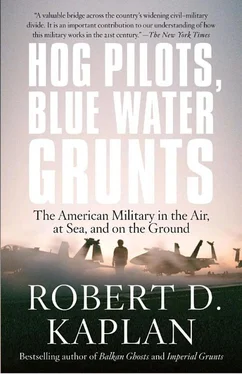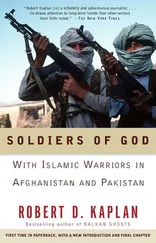All these incidents represented exactly what I had experienced with the Marines in Iraq the previous spring. The essential reality of Iraq had been communicated successfully down the chain of command to this battalion in Alaska: a field artillery unit in an unconventional environment faced many challenges that had nothing to do with field artillery.
The Arctic, rather than being unrealistic of Iraq, was good preparation for it. War fighting, particularly in the high-tech twenty-first century, relied on logistics: making sure there were enough MREs, enough battery chargers for intra-squad radios and night-vision goggles, enough ammunition, and so on. The Arctic was an intensification of this burden. In the heat, if you didn’t bring enough socks or underwear, you were uncomfortable, but you weren’t disabled. In the Arctic, if you didn’t pack perfectly you got frostbite, or worse. In the Arctic, every little detail, like zeroing your gunsight, was more difficult because you had to do it with gloves on. In the Arctic, you simply had more things to remember—more clothes to bring, more requirements for protecting your electronic equipment. I remembered what Army Col. Tom Wilhelm, a veteran of the Cold War Arctic infantry, had told me eighteen months earlier in Mongolia: in the Arctic every movement had to be planned minutely since you couldn’t afford to break a sweat, because once you stopped sweating you’d turn into a Popsicle.
Since extremely cold weather demanded more planning, it developed leadership. If even one private touched a piece of metal with a bare, frostbitten finger, it could tear some skin off and end the career of his immediate commander. And Iraq, among many other things, was about the effectiveness of platoon-level commanders. Though Green Berets could be very critical of the rest of the Army, they often made an exception for the units in Alaska. There was something about the severe cold, they had told me, that bred good soldiers.
I wandered into the battalion TOC (tactical operations center) and reentered Iraq. There was a beehive of activity under a large canvas tent, with laptops and Blue Force Trackers (satellite-based tracking and communication systems), and separate huddles taking place about the latest incident. The only difference was the vapor-barrier boots that everyone wore against the cold. Elsewhere in the tundra I found a mock Iraqi village with the Islamic prayer call blasting over loudspeakers, and cruddy cement blockhouses, like so many I had seen in Iraq, which, when you entered them, revealed a chaos of cheesy furniture and the Arabic language screams of children coming through hidden speakers.
FROM PACOM TO NORTHCOM
Deploying soldiers to Iraq was a typical task for PACOM, which traditionally supplied many of the troops with which CENTCOM (Central Command) fought its Middle Eastern wars. But to see the NORTHCOM homeland security element of the U.S. military in Alaska, I had to journey for several hours southeast from Fort Wainwright to Fort Greely, past a section of the Alaskan pipeline, through the morbid virginity of ice-curdled streams and unyielding birch forests. Fort Greely, named for Army Maj. Gen. Adolphus Greely, an early-twentieth-century Arctic explorer, was a key component of President Bush’s emerging missile defense program. For the nearby town of Delta Junction, which boasted a couple of auto parts stores, one liquor store, and ten churches, the missile base represented the only economic hope.
The missile site was in a quasi-state of activation. Many of the underground silos were filled with interceptor missiles; others waited to be filled. The system was being tested and had yet to be turned on for actual deployment. The key acronym here was FCS (fire control system), insipid bureaucratic dialect for “killing,” or intercepting, an incoming missile from a rogue state like North Korea. “It’s a surface-to-air system on steroids,” explained Army Lt. Col. Greg Bowen of Grand Forks, North Dakota, the local commander. The kill would take place in “mid-course,” that is, when the incoming missile was at the highest point of its trajectory a hundred miles above earth, allowing the defender missile time to adjust its own course.
Many serious questions remained about the effectiveness of such a system, designed not to protect against a barrage of incoming missiles from a superpower like the Soviet Union, but against a single projectile fired by a relatively poor and radicalized country. Because such a country could not afford an arms race, this system, however imperfect and untested, might be able, it was claimed, to deter simply because of its existence. As for the threat posed by an emerging superpower, such as China, well, in such a hypothetical situation, other systems would have to be built. Fort Greely was but one “layer” of a growing missile defense network that would soon feature giant, offshore radar platforms floating off the most distant of the Aleutian Islands, close to East Asia.
The untested technology did not interest me as much as other things here. Responsibility for the entire facility rested with two hundred Alaskan national guardsmen commanded by Lt. Col. Bowen. Because they lived locally and had been assigned to Fort Greely for a decade already, they had developed an occupational expertise that you rarely encountered in the regular Army, where everyone was constantly being moved around. They reminded me of the Texas and Florida national guardsmen in Army Special Forces with whom I had been embedded the year before on the Afghanistan-Pakistan border. The Texans and Floridians were cops and state troopers in private life, whose community policing skills were vital in dealing with teenagers in Afghan border villages. National guardsmen—often a network of “good old boys”—were inching their way toward the front lines for both the exterior War on Terrorism and the interior function of homeland security. The guardsmen here interacted fine with the private contractors at the heart of missile defense; it was the active-duty military that was missing, for the missile defense system at Fort Greely was built and maintained by Boeing. The “industrial” part of the “military-industrial complex” had always been private. It was witnessing the tangible reality that made me realize just how inextricable the two parts of that concept were.
Another interesting facet about Greely was that it looked like nothing; it was a bunch of flat-roofed concrete-block facilities, almost Soviet in their ugliness, on a grubby white Arctic desert haunted by caribou, and filled with tractors, forklifts, and shipping containers. The only indication of the actual underground missile site, which included miles of tunnels, was the candy-cane-shaped aluminum air vents sticking out of the ground, reminiscent of any residential septic field. In the distance were granite peaks painted with ice and snow, standing between the Alaska and Brooks ranges.
The biggest social event at Fort Greely was the square dances at the base MWR (Morale, Welfare, and Recreation) facility. It certainly was a bleak landscape, both culturally and geologically. But as missile technology went forward, along with the Air Force’s ability to transport troops over the pole, the Arctic was destined to play a large role in America’s military future, one that had not gone away with the passing of the Cold War, with its polar trajectories for nuclear missiles and its submarine sorties in the marginal ice.
On the way back to Fort Wainwright, I spotted a moose with her calf in the deep snow. Twenty-four hours later, a series of military and commercial flights brought me from the Arctic Circle to the Tropic of Cancer—to Honolulu, where a tropical rainstorm was in progress.
———
Honolulu, halfway across the Pacific, was the headquarters of PACOM. Here my Pacific odyssey would start in earnest, as would my introduction to the world of the Navy and Air Force, after two years with Army Special Forces and the Marines. I had stopped at PACOM in the summer of 2003, en route to embedding with the Army’s 1st Special Forces Group in the southern Philippines, and I had been back several times since. [9] See Chapter 4 of Imperial Grunts for a description of PACOM headquarters overlooking Pearl Harbor, the PACOM area of responsibility, and the Hawaiian island of Oahu’s significance to the U.S. military.
It being the weekend, I went to two hallowed sites I had missed on previous visits.
Читать дальше












